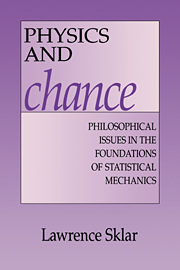Book contents
- Frontmatter
- Contents
- Preface
- 1 Introduction
- 2 Historical sketch
- 3 Probability
- 4 Statistical explanation
- 5 Equilibrium theory
- 6 Describing non-equilibrium
- 7 Rationalizing non-equilibrium theory
- 8 Cosmology and irreversibility
- 9 The reduction of thermodynamics to statistical mechanics
- 10 The direction of time
- 11 The current state of major questions
- References
- Index
6 - Describing non-equilibrium
Published online by Cambridge University Press: 04 December 2009
- Frontmatter
- Contents
- Preface
- 1 Introduction
- 2 Historical sketch
- 3 Probability
- 4 Statistical explanation
- 5 Equilibrium theory
- 6 Describing non-equilibrium
- 7 Rationalizing non-equilibrium theory
- 8 Cosmology and irreversibility
- 9 The reduction of thermodynamics to statistical mechanics
- 10 The direction of time
- 11 The current state of major questions
- References
- Index
Summary
The aims of the non-equilibrium theory
What results might we want to obtain from a statistical mechanical theory of non-equilibrium? Even a brief itemization of our ability to describe the non-equilibrium situation in macroscopic terms will be sufficient to indicate the breadth and depth of the results we would like to underpin with a statistical, microscopic theory.
It is an experimental fact that many non-equilibrium states of matter (and radiation) can be characterized in terms of a small number of field parameters — that is, assignments of values of a physical quantity by means of a function from locations in the system to numerical values. In general, these parameters are derived from those we use to characterize the equilibrium situation by a kind of generalization. Thus, such kinematic and dynamical quantities as energy, pressure, and volume are carried over, except that an intensive quantity like pressure now becomes local pressure at a point. And such purely thermodynamic quantities as temperature and entropy are generalized to local temperature and local entropy production. So the macroscopic situations with which we expect to be able to deal, at least most straightforwardly, in statistical mechanics are those of systems that are either close to equilibrium or that, although far from equilibrium, are such that they can be described in terms borrowed from equilibrium theory in small enough spatio-temporal regions of them.
- Type
- Chapter
- Information
- Physics and ChancePhilosophical Issues in the Foundations of Statistical Mechanics, pp. 196 - 218Publisher: Cambridge University PressPrint publication year: 1993



